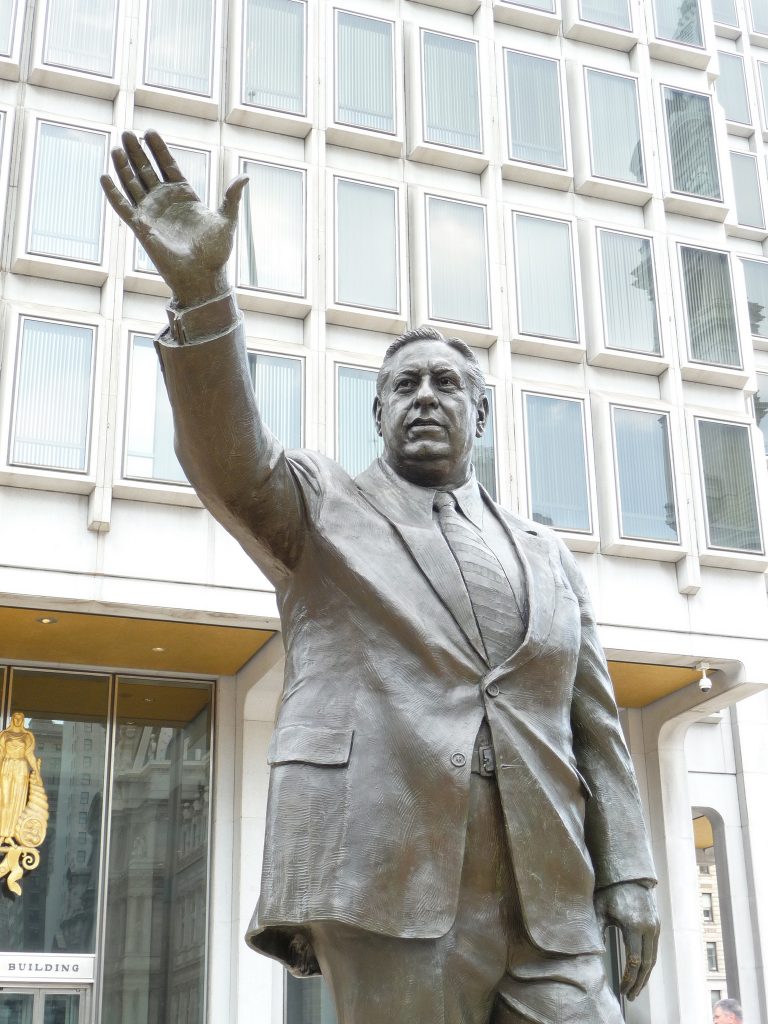
Putting up a statue to Frank Rizzo in a plaza named after Tom Paine wasn’t as bad as putting up a statue of the Devil in the Sistine Chapel would have been, but it did come in a close second. Tom Paine was the most celebrated pamphleteer of the American Revolution, and he still talks straighter about the values of freedom and democracy than anyone else ever has. Frank Rizzo, as Philadelphia’s police commissioner in the turbulent 1960s and as mayor from 1972 to 1980, was an unabashed, brass-knuckle white supremacist who terrorized the city’s African-American population for two decades, not to say waged war on it, and left a legacy of brutality and injustice that long outlasted him and is still deeply ingrained in the city’s police culture today.
True, he had a dedicated political following, roughly from the same constituency that now supports Donald Trump, and a lot of people with the same skin color as him liked to call him Frank. But when his statue went up opposite City Hall to make a threesome with Ben Franklin atop it and George Washington outside Independence Hall, I had to think the Founding Fathers were spinning in their graves. True, Washington owned slaves, and Rizzo didn’t. He just treated blacks in Philadelphia as if they deserved no better than chains and everyone’s civil liberties as an inconvenience to the men in blue.
When tyrants fall, their statues are usually smashed. Everyone old enough to have witnessed the fall of Baghdad in 2003 will remember the endlessly played footage of Saddam Hussein’s statue dragged off its plinth and pulverized by the joyous crowds who welcomed the Iraq war, at least for a day. Rizzo’s statue won’t meet that fate; it will be hauled off to someplace suitable, perhaps outside a Chickie’s and Pete’s, or to join Rocky beside the Art Museum. What took Frank down was the movement to dismantle the monuments to the Confederacy for the past century and more throughout the South and pockets of the Union North, including the United States Capitol. The occasion for that was the murder two years ago of nine African-American church elders in Charleston, South Carolina by Dylann Roof. Nine’s a small number as massacres go in America — this day as I write 26 or more have been slain in another church, in Sutherland Springs, Texas — but Roof’s utter cold-bloodedness finally struck the chord that rendered public celebrations of slavery too much, even in Donald Trump’s America.
The statues matter, because the South has never stopped fighting the Civil War, and they represent the great lie that it had a cause worthy to defend. It’s a lie that now comes not out of the mouths of a Theodore Bilbo or a Strom Thurmond, but from the White House that Abraham Lincoln lived in. When Trump says that the neo-fascist, neo-Confederate marchers who tried to take over Charlottesville, Virginia last summer had “good people” among them, he is apologizing for racism and slavery. When, in his sublime ignorance of history and basic chronology, he says that Andrew Jackson could have averted the Civil War if only people had listened to his good sense and wisdom, or when his chief of staff, John Kelly — supposedly one of the adults in the White House — calls the war a struggle for states’ rights that resulted from a failure to compromise — our highest officials are beating the drums for Jefferson Davis, more than 150 years after Lee’s surrender at Appomattox.
The fact is that the original sin of this nation — the enslavement of one race by another — has been with us precisely because of compromise with truth and right, and that such compromises not only preceded the Civil War but succeeded it, and have been alive to the present day. Our Constitution was founded on such compromise, defining each enslaved black as three-fifths of a human being for purposes of the national census and Congressional apportionment. The Missouri Compromise and the Kansas-Nebraska Act, both of which envisioned the further spread of slavery, were precisely those efforts to split the difference with evil that Kelly, a four-star general, apparently never heard of. The Compromise of 1877 that marked the end of postwar Reconstruction left former slaves at the tender mercies of Jim Crow for a century, perpetuating indentured servitude in all but name and licensing segregation and discrimination elsewhere in the country. Hymns were sung to the plantation culture of the antebellum South, and one of them, Margaret Mitchell’s “Gone With the Wind,” became (at least with white audiences) the most popular and beloved film of the 20th century.
So, where are we? Nine months after the departure of our first African-American president from office, we have the most openly racist presidency since that of Woodrow Wilson, and perhaps the most brazen one since before the Civil War itself. Original sin is like that; it keeps coming back to bite you. I’m not sure how we repent or where forgiveness lies. But we have to live with our history and face its truth. We aren’t better or wiser than our Founding Fathers, but we can try to live up to the ideal they gave us — one nation, with liberty and justice for all — even if they couldn’t do it themselves. Taking down the statues that should affront all of us, including the one that has mocked every African-American citizen of Philadelphia who’s had to walk past it, is at least a start. I wouldn’t mind seeing the statues of Frederick Douglass or Martin Luther King Jr. in place of Frank Rizzo’s, and I don’t think Tom Paine would either. Or, if you want something with a more directly pertinent civic theme, how about the victims of the MOVE bombing? The space is free.

